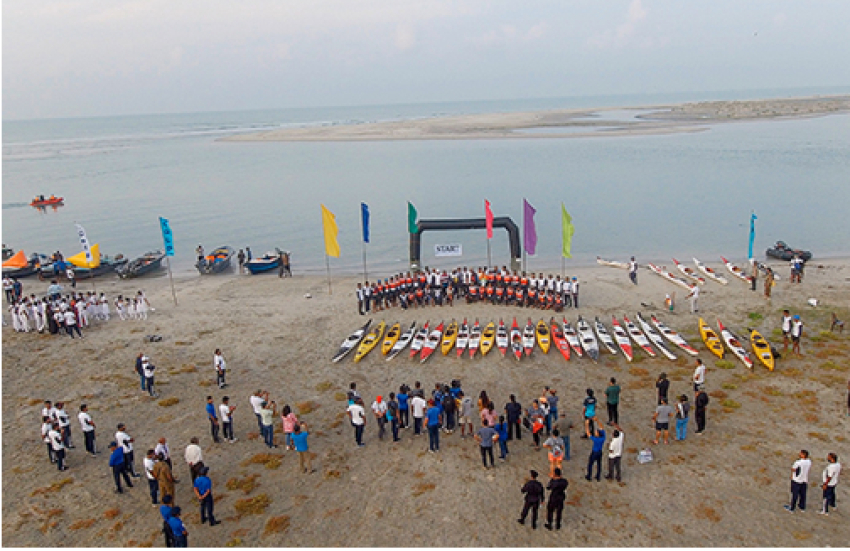Acid rain went from being a pollution disaster to an environmental success story. How did scientists manage to prove that acid rain existed, and find a way to stop it?
By Lesley Evans Ogden
A group of kids canoeing in Canada’s Killarney Provincial Park are paddling across a serene and unnaturally turquoise lake. It’s a hot sunny day, and a thirsty boy dips an aluminium cooking pot into the water to refill his fellow canoeist’s canteens. In a momentary lapse of concentration, the pot slips from his grasp. As it sinks underwater beyond reach, what’s incredible is that it’s visible all the way down to the lake floor some 50ft (15.2m) below.
It’s the mid-1980s. One of the kid canoeists is me, and there’s an unfortunate explanation for this water clarity. This lake, near the nickel and copper smelters of the town of Sudbury, Ontario, has been radically altered by acid rain. Almost every living thing in the water – like the tiny algae that would normally block light from reaching the depths – has gone, leaving the water here and in lakes across the region a beautiful but eerily lifeless aquamarine.
You might also like:
• The wildlife haven in a Cold War death strip
• How vaccines could fix our problem with cow emissions
• How do you bring wildlife back to the city
Fast forward to 2019 and another set of lakes in a remote corner of north-west Ontario. Biologist Cyndy Desjardins is sipping coffee at breakfast following a nocturnal boat trip at the International Institute for Sustainable Development’s Experimental Lakes Area (IISD-ELA). Smiling but sleepy, she spent much of the night working in nearly pitch-dark conditions, surveying for tiny monster-like creatures: freshwater opossum shrimp called Mysis relicta. Desjardins is part of a team attempting to close the loop on an acid rain experiment that began in the 1970s.
Bitter controversy
At its worst, acid rain stripped forests bare in Europe, wiped lakes clear of life in parts of Canada and the US, and harmed human health and crops in China where the problem persists. Looking back today, there is little argument that the cause was sulphur dioxide and nitrogen oxides emitted by fossil fuel combustion by cars and industrial facilities like smelters and coal-burning utilities. When combined with water and oxygen in the atmosphere, these air pollutants chemically transform into sulphuric and nitric acid. Acidic droplets in clouds then fall as rain, snow or hail.
We know this now. But for a long time, acid rain was a puzzle. In 1963, as part of a long-term ecosystem study that is still ongoing today, Gene Likens collected a sample of rain at the Hubbard Brook Experimental Forest in New Hampshire’s White Mountains. That sample was “about a hundred times more acidic than we thought it should be”, says Likens, now emeritus professor in ecology at the Cary Institute of Ecosystem Sciences in Millbrook, New York. His discovery back in 1963, on the heels of work dating back to 1872 and even earlier, set the collective wheels in motion to raise awareness and isolate the cause of acid rain. Not just in North America, but across the industrialised world.
Scientists would protectively suit up like Darth Vader, make a sulphuric acid solution and use the boat propeller to mix the cocktail across the whole lake.
Other crucial evidence that led to action on acid rain – on both sides of the Canada-US border – came from experiments at north-west Ontario’s Experimental Lakes Area (ELA). Its soft-water lakes were far enough from sources of pollution that they had escaped the effects of acid rain, acting as a control.
Unlike many lakes, composition of the healthy ecosystem in the ELA was well documented. That enabled scientists like David Schindler, then an ELA senior scientist and now emeritus professor at the University of Alberta, Canada, to add acid experimentally to one lake and see how the ecosystem responded. ELA scientists would protectively suit up like Darth Vader, make a sulphuric acid solution and use the boat propeller to mix the cocktail across one of the lakes.
Over seven years beginning in 1976, they lowered the pH of one lake, number 223, from 6.8 (close to neutral) to 5.0 (slightly acidic). Lab studies had suggested a pH of 5.0 would not harm fish. But in the lake 223 experiment, long before it reached 5.0, it did. By the time the pH reached 5.6, most of the lake trout’s preferred food – tiny organisms that require calcium to form exoskeletons – had died as acidified waters dissolved their protective coats.
“Lake trout stopped reproducing not because they were toxified by the acid, but because they were starving to death,” says Schindler.
Lake trout stopped reproducing not because they were toxified by the acid, but because they were starving to death - David Schindler
Freshwater microbiologist Carol Kelly arrived at ELA in 1978 just as acid rain experiments got underway. She became curious about a particular puzzle the lake acidification experiments had stumbled on. Her colleagues had carefully calculated the quantity of acid needed to drop lake 223’s pH to 5.0 – a simple calculation a high-school student could do. But out in the lake it became clear that their calculations were way out of whack.
“I had given the crew orders to take the lake down to a given pH and then add enough acid to hold it there,” says Schindler. Part way through the season, the crew reported that they were running out of acid. Acidifying the lake took way more than they thought, says Kelly. “The question became, where is it going?” she says.
Kelly and colleagues set to work to find out, and discovered that alkali-producing microbes were capable of buffering some of the acidity, helping the lake chemistry to recover. That acid could be neutralised by bacteria living in every lake was a controversial finding at the time.
“People didn’t believe it,” Kelly says. But she continued to find out just how much acid microbes could neutralise, travelling elsewhere in Canada, the US and Norway to lakes that had been acidified atmospherically, to test this natural recovery ability. The discovery that acid-neutralising bugs exist in the sediment in lots of lakes, not just at the ELA, suggested that lakes could recover if the pollution causing the acid rain were eliminated.
Doubt and denial
Compelling photographs of starving fish from lake 223, combined with efforts by environmental groups like the Canadian Coalition on Acid Rain, helped persuade policymakers – eventually – to legislate more rigorous air quality standards.
But acid rain research at ELA almost didn’t happen at all. Founded to address the issue of excess nutrients contaminating lakes, work that had already drawn far-reaching conclusions by the early 1970s, Canada’s federal government was poised to pull the plug on the research station. At a presentation to federal fisheries officials, Schindler says that despite considerable evidence from the US, one official accused him of inventing the idea of acid rain just to save the ELA.
Scientists began pinpointing culprits and journalists covered the problem through the 1970s and 1980s, but some people working in industry were doing their best to obfuscate, sow doubt and delay action.
“There were lots of deniers of acid rain,” says Likens. At the time, Likens remembers giving public lectures on the topic. On occasion someone would stand up, rudely interrupt him, and say they didn’t believe in acid rain. “I would often respond by saying, ‘Well, have you ever collected a sample of rain and analysed it?’ They would say ‘No’ and I would say, ‘Well try it some time.’”
Like with climate change, says Likens, there were many big, powerful, wealthy people involved with vested interests. From its discovery in 1963 to passage of the Clean Air Act in 1990, legislative action on acid rain took 27 years.
Over that time, many a cross-border argument erupted. “The first international altercation over acid rain was the US accusing Canada of acidifying lakes in the boundary waters,” says Schindler. The squabble was over a small coal-burning power plant in Atikokan, Ontario, that US representatives claimed was sending acid rain south of the border. Schindler attended a meeting in Minneapolis, Minnesota, along with other Canadian scientists and their US counterparts.
Acid rain was at one time the number one Canada-US bilateral issue - Adèle Hurley
“When all the data were on the table, it was clear that the little bit of sulphur from Atikokan was inconsequential to boundary waters,” Schindler says. At the same meeting, scientists examined net international flows of emissions. It became obvious, says Schindler, that the US, particularly the Ohio Valley and industrial areas of Pennsylvania and New England, were producing more than half the acid rain that collected in Canadian lakes.
The blame game continued, and acid rain “was at one time the number one Canada-US bilateral issue”, said Adèle Hurley in a speech reflecting on decades of work with the Canadian Coalition on Acid Rain, which she co-founded in 1981. The coalition was eventually disbanded following amendments to the US Clean Air Act in November 1990, establishment of the Acid Rain Program, and parallel action on the Canadian side.
Lessons from the lakes
A half-century after those early experiments, lake 223 in the ELA is no longer acidic, the acid-eating microbes having done their job. Lake chemistry has returned to its pre-experimental state. Biological recovery, however, has lagged behind. Freshwater opossum shrimp are found in healthy numbers in untouched control lakes. But in 223, they are still missing. So, Desjardins and others are investigating whether reintroductions of the opossum shrimp – 10,000 painstakingly counted at a time – might jumpstart biological recovery of the ecosystem.
Early signs look positive. Remote operated underwater vehicles searching for evidence of these mini-monsters of the deep have spotted just two Mysis shrimp swimming freely in lakes thus far, but it suggests that all that midnight catching and counting in the dark is not in vain – these tiny missing links in the ecosystem eroded by acid rain may be coming back.
Broader recovery, in lakes across North America, happened because acid rain was tackled at its source.
Compared with 1990 levels, sulphate ions in the atmosphere have dropped considerably, reduced to almost negligible levels at former hotspots. But the problem has not disappeared altogether. Nitrates from sources like agriculturally emitted ammonia released from fertilisers and livestock feed remain a contributor to nitric acid precipitation. And there is concern that acid rain – from both sulphur and nitrogen – is an increasing problem in Asia.
There are no simple solutions to complex environmental problems. But are there parallels between efforts to curb acid rain and strategies for action on climate change? Schindler does see similarities in the procrastination tactics employed by industry. “Seed enough doubt, and pay for enough political campaigns, and you can delay action,” he says. “That sounds pretty crass but if you look closely, that’s how most environmental problems are addressed, and climate is no exception.”
Despite this, emissions reductions have been a huge success story in tackling acid rain, says Likens. But further reductions, especially on nitrogen oxides, are needed. The current US president is proposing to cut back regulations on emissions. If this happens, says Likens, recovering lakes in places like the Adirondack Mountains in north eastern New York would be particularly vulnerable, their acid-neutralising capacity already weakened.
Tackling acid rain in North America required actions in two neighbouring countries. But for climate change, the challenge is broader and solutions must be global. Nevertheless, the two issues do share similarities. Both, says Hurley, require cutting-edge science, media coverage and finding common ground, building coalitions between opposing parties.
In the fight Hurley helped to lead against acid rain, this meant talking to coal workers at sportsmen’s shows, engaging them in conversations about clean water for fishing salmon, and going for walks in war cemeteries where acidity was ruining the limestone of gravestones.
Though aspects of its legacy remain, solutions to the acid rain problem moved forward, in North America at least, because it became a non-partisan issue. Hurley reflects that “a broad spectrum of people came to believe that it was important to protect natural resources – our forests, our northern lakes and the fish they contain – resources that belong to everyone”.
If anything can be learned from the acid rain story, it’s that the same breadth of support and dismantling of partisanship is necessary for protecting the Earth’s climate.
How do you bring wildlife back to the city?
Many cities are challenging places for wildlife, full of people, noise and pollution. But small changes are all it takes to tempt many species to live in the concrete jungle.
By Martha Henriques
Urban rewilding projects are tempting nature back into our cities, from creating city butterfly meadows to building unlikely homes for deadly birds of prey.The middle of London’s hectic West End doesn’t seem like the likeliest location for one of the UK’s rarest birds. There are only an estimated 20-40 breeding pairs of black redstarts in the country. But in recent years, without being artificially introduced into the area, this rare bird has started to make a home in this crowded part of Central London.The black redstart isn’t the only unexpected species of wildlife to start living in conspicuously urban landscapes. Moths, butterflies, woodpeckers and even serotine bats, more commonly found in rural pastures, have also been on the rise in this part of London.It’s a trend growing in strength worldwide. While in New York, peregrine falcons – once nearly extinct in the US, can now regularly be seen diving at breakneck speeds from skyscrapers across the city.
You might also like:
Seven big challenges for tomorrow’s leaders
The teenage scientist tracking a sea of space junk
The drone that sniffs out landmines
These changes are the payoff of increasing efforts to transform dense urban areas from wildlife dead-spots into attractive, viable homes for nature alongside city dwellers. One new initiative is even trying to get offices to keep beehives.
You don’t have to completely redesign a city’s layout to achieve this, says Emily Woodason, a senior landscape architect at the design and planning firm Arup. Sometimes creating pockets of greenery at sufficiently regular intervals is enough to tempt wildlife back into an area. The Wild West End project, involving six of London’s largest landowners, is seeking to create 100 square metres (330 sq ft) of green space every 100m.
“It’s an ambitious objective,” says Woodason. “Ultimately the aim is to create a green corridor between London’s parks.”
As well as planning more green areas, many of the landowners are choosing to retrofit existing buildings with green walls or roofs. So far, it appears to be working. Since a baseline wildlife assessment two years ago, several unexpected species have returned to the area, including the black redstart.
“One of the types of space created might include rock piles and log piles, which are great at attracting different insects and allow more natural colonisation of species over time,” says Woodason. “Those conditions are perfect for this type of bird.”
We realise that planning, development, architecture and industrial design are all complicit in wiping out other species on this planet – Mitchell Joachim
Attracting rare species back to cities isn’t just “nice to have”, although it does make urban life more varied and interesting. Some of the species tempted back by such programmes are the ones we rely on heavily for food security, such as pollinators like bees and butterflies. Their populations are plummeting globally.
“We realise that planning, development, architecture and industrial design are all complicit in wiping out other species on this planet,” says Mitchell Joachim, director and co-founder of Terreform, an ecological planning and architecture firm. “I am absolutely passionate about trying to restore these habitats in cities, and to instil that in how we plan our buildings.”
Sometimes that means planning a giant, eight-storey transparent vertical meadow into the walls of an office building in Manhattan. Monarch butterflies are native to North America but have been disappearing fast since the 1980s because of widespread destruction of milkweed, a plant that monarchs use while breeding. “Milkweed is a highly invasive species, humans don’t like it – it can give you a rash, or take over your beautiful American lawn,” says Mitchell.
Building a space for monarchs into the building would be part of an effort to slow their precipitous decline.
“It is a sanctuary for monarch butterflies, to breed them, with nurseries for caterpillars and areas for the chrysalises and the adult butterflies,” says Joachim. “They live there for a few weeks and then they’re released.”
To have a real impact on monarch butterfly populations, it will take more than one sanctuary. The most important thing to do is restore the butterfly’s natural habitat – within the city and outside it along its migration route to Mexico – in particular by providing more milkweed.
In cities, a roof garden is the obvious place to start allowing milkweed to grow. One such roof garden is planned to sit on top of the butterfly building, which the insects are greeted with when they are released into the open air. But this is something that everyone who owns or rents a property can contribute to, not just the proprietors of large landmark buildings. To make a long-term difference, people need to look past the state of their lawns and leave the milkweed intact.
One place that the peregrine falcons thrived turned out to be quite unexpected
Sometimes wildlife returns to a city not because people carve out a designated space for them, but because something toxic to them is removed. The pesticide DDT, originally considered a wonder chemical, was used widely in agriculture from the 1940s. It wasn’t until decades later that people discovered it was highly toxic to many species, including humans, and the US’s Environment Protection Agency (EPA) banned it in 1972.
Among the worst affected were birds of prey, because the toxin accumulated up the food chain. The US population of peregrine falcons, the world’s fastest bird of prey, was decimated and by 1970 the birds were on the edge of extinction.
A group of scientists set up a conservation initiative they called the Peregrine Fund, to try to breed peregrines in captivity until they could be released into the wild. One place that the peregrine falcons thrived turned out to be quite unexpected.
“They started to experiment with releasing peregrine falcons into cities,” says Erin Katzner, director of global engagement at the Peregrine Fund. “Not only did it work, it worked really well.”
The skyscrapers provided a habitat that the birds were well adapted to – high up, with sheer drops, with spots to nest far away from potential predators like racoons or foxes. Scientists worked with building owners to create ledges for the birds to nest on. Pigeons and migratory birds provided plentiful food. As pollution of the food chain with DDT declined, peregrine falcon populations in cities soared.
“Now you can find them in almost every city across the US, including multiple pairs in Manhattan,” says Katzner. “You can go into downtown New York City and see peregrines flying among the skyscrapers.”
The long-game is not just to build in green compromises to existing city areas, but to shift what development looks like in a city
Even for birds released into the countryside, there are now many accounts of them making their way to cities of their own accord, because they had become such a good habitat. As well as exciting birdwatchers, urban birds of prey help to keep down rodent populations within the cities.
Urban rewilding initiatives often have multiple levels of benefit – greener spaces make people happier, but they also help solve water drainage problems and prevent flooding, as well as providing a home for pollinators and other animals. But perhaps one of their most valuable traits is to make people feel more connected with nature and be more aware of our relationship with the environment.
The long-game is not just to build in green compromises to existing city areas, but to shift what development looks like in a city. Until recent years, urbanisation has meant turning green areas grey with the concrete, asphalt and glass of traditional buildings and infrastructure. That transformation has unsurprisingly ended up being bad for our mental wellbeing, physical health, environment, ecosystems and wildlife.
Rewilding is one way to reverse that process: prioritising plants and animals first, and paving the way for the benefits to our health, wellbeing and the urban environment that follow




















